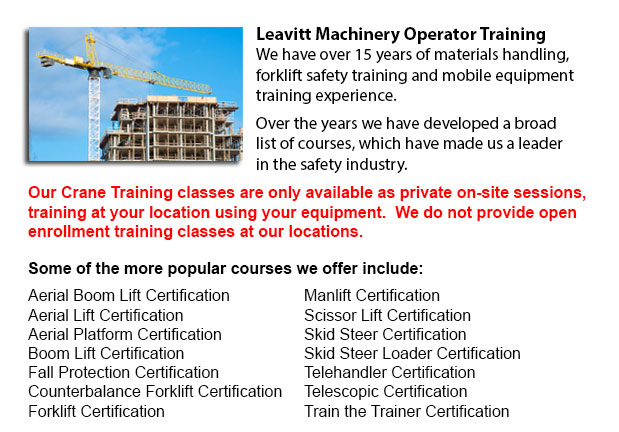
Crane Certification BC - The Crane Certification training program includes content suggested by industry about the efficient and safe operation of cranes. Trainees would be taught the following: how to identify cranes and their component parts; pre-operational, operational and post-operating requirements; rigging components and inspection/rejection criteria; how to determine overall lift capacity; and needs specific to the work place where the trainees will be operating.
The requirements that should be performed before operating a crane such as assigning authority for the pre-operational check; performing the sequential pre-operational check based on the specifications certified by a professional engineer or manufacturer's specifications; inspecting the work area for obstacles and hazards; checking the log book for comments; checking cables, hooks, chains crane movement and safety latches; ensuring the proper functioning of operational controls; and knowing how to make certain that the disconnect switch/isolator of the crane is working right.
Operational requirements consist of identifying roles and responsibilities, and determining the requirement for a formal lift plan. Individuals training would be taught how to perform a hazard assessment related to environmental circumstances, physical circumstances and employees. Subject matter includes determining when to seek competent help, the safest route and destination of loads, and load weight and centre of gravity.
Individuals training must be able to identify an over-capacity lift, in addition to be able to pick correct rigging machinery, choose load limits, and to determine the safe spot for the crane to operate from. Trainees will review both universal and site-specific crane signals for lifts, and methods for loading, traveling and lifting. Proper maintenance habits will be included.
The person training will undergo an examination to test their understanding of emergency response procedures for various situations, specifically mechanical or electrical failures. They would be asked to describe parking and shut down procedures for security and safety, to follow tagging and lock out techniques, and to explain the reason why near misses are recorded and reported to the appropriate individual. Log book records have to be maintained.
The person training will be taught the particulars of rigging, and learn the authority and responsibility for rigging. They would know to identify the various kinds of rigging, the load capacity ratings and storage procedures.
The requirements after operation of the crane would be taught also, learning to enter the deficiencies and defects; and to log the history of service and maintenance records, in accordance to the federal, state and provincial codes requirements.
Site-specific needs can be incorporated into the safety training program according to the employer's needs.
-
Zoom Boom Ticket BC
Zoom Boom Ticket BC - Zoom Boom Training focuses on correctly training prospective operators on variable reach forklifts. The training objectives include gaining the understanding of the equipments physics and to be able to define the job of the oper... More -
Scissor Lift Training BC
Scissor Lift Training BC - When operating a scissor lift, they should be used competently in order to protect the wellbeing of the other personnel in the workplace and to protect the safety of the equipment. Operators who are skilled are trained to d... More -
Wheel and Track Loader Training in BC
Lift trucks are obtainable in several load capacities and several models. Nearly all forklifts in a regular warehouse surroundings have load capacities between one to five tons. Bigger scale models are used for heavier loads, like loading shipping co... More -
Zoom Boom Training BC
Zoom Boom Training BC - Zoom Boom Training focuses on properly training prospective operators on variable reach forklifts. The training goals consist of gaining the knowledge of the machine's physics and to define the responsibilities of the operator... More -
Heavy Equipment Operator Certification BC
Heavy Equipment Operator Certification BC - The heavy equipment operator is a person who manipulates the controls and drives various types of huge machinery. Heavy machinery is most commonly used on construction sites to deliver supplies to the site... More -
Crane Ticket BC
Crane Ticket BC - New cranes can either be complex or simple, based on the nature of the application they are able to do. For example, mobile cranes are rather simple models. A steel truss and even a telescopic boom mounts its movable platform. A sys... More -
Telehandler Training in BC
Telescopic handlers normally known as telehandlers for short, are a very popular piece of heavy construction machinery. They are commonly utilized in the construction and agricultural industries. These equipments have maximum reaching capacity and ar... More -
Wheel Loader Training BC
Wheel Loader Training BC - Normally, the various types of heavy equipment training are divided into 2 categories of equipment: those which have rubber tires and tracked vehicles. Tracked vehicles comprise items like excavators, cranes, and bulldozers... More

Forklift Training BC
TOLL FREE: 1-888-254-6157
forkliftcertificationbritishcolumbia.com
Email Us
About Us


